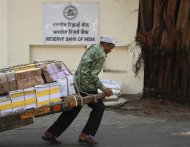The company blamed the first-quarter decline, which surprised some on Wall Street, on seasonal advertising trends.
"It was a faster slowdown than we would have guessed," said Brian Wieser, an analyst with Pivotal Research Group.
"No
matter how you slice it, for a company that is perceived as growing so
rapidly, to slow so much on whatever basis - sequentially or annually -
it will be somewhat concerning to investors if faced with a lofty
valuation," Wieser said.
Facebook
is preparing to raise at least $5 billion in an initial public offering
that could value the world's largest social network at up to $100
billion.
"The biggest issue is the
realization that Facebook is not going to have an easy time meeting high
expectations of the public market," said Jeff Sica, chief investment
officer of SICA Wealth Management, which manages more than $1 billion in
client assets, real estate and private equity holdings. "It will affect
how people look at the IPO."
Investors
are still likely to sign up in droves for the IPO; However, growth
concerns may make some investors less likely to keep the stock over the
long term, he added.
"I'm still
encouraging people to participate in the IPO, under the acknowledgement
that it could be a bumpy ride," Sica said. "There are high expectations
and I hate high expectations."
The
company, founded by Mark Zuckerberg in a Harvard University dorm room in
2004, surpassed 900 million monthly active users in the first quarter
and said its full-time staff grew by about 1,100 employees to 3,539 in
the past 12 months, according to an updated filing with the U.S.
Securities and Exchange Commission on Monday.
Facebook
also disclosed that it has agreed to pay Instagram $200 million if the
company's recent deal to buy the photo-sharing start-up for about $1
billion does not go through.
Facebook
said it paid $300 million in cash for Instagram, along with 23 million
shares of Class B common stock. It said the fair value of its Class B
common stock was $30.89 per share as of January 31.
Spending roughly doubled over the past 12 months, outpacing the 45 percent revenue increase during the period, it said.
Net income slid 12 percent to $205 million in the quarter, from $233 million a year earlier at the rapidly expanding company.
Facebook
said its advertising business, which accounts for the bulk of its
revenue, typically slows down in the first three months of the year. The
rapid advertising growth may have "partially masked" such trends to
date, and seasonal impacts may be more pronounced in the future, it
noted.
Revenue, which totaled
$1.06 billion in the three months ended March 31, declined 6 percent
from the fourth quarter. It was the first quarter-on-quarter drop since
at least 2010.
"It was bound to
happen. You are going to see a slowdown," said Anupam Palit, an analyst
at GreenCrest Capital LLC, noting that it is harder to double revenue
when the base is larger.
But he
also said Facebook has not worked out how to make more money in some
international markets where it is growing the fastest, such as
Brazil, India and the Philippines.
"They have not cracked international markets yet, while others like Google do very well internationally," Palit added.
Apart
from slowing growth, Facebook is also grappling with other issues.
Yahoo Inc is suing it for patent infringement even as the social
networking company tries to beef up its intellectual property arsenal.
On Monday, it said it would pay $550 million for hundreds of patents
from Microsoft Corp.
PAYMENTS HINT
Facebook
gets most of its revenue from advertising, but has a Payments business
centered around Facebook Credits, a virtual currency used mainly to buy
virtual goods within social games.
However, the company hinted at a possible an expansion of Facebook Credits into other areas.
Facebook gets a cut of up to 30 percent from virtual goods sales on its platform.
"In
the future, if we extend Payments outside of games, the percentage fee
we receive from developers may vary," the company said in its IPO filing
on Monday.
Some investors expect
e-commerce to be a major area of expansion for Facebook. Some industry
experts said that if Facebook Credits were used for purchases of
physical goods, the company's cut would have to be a lot lower than 30
percent.
(Reporting By Alistair Barr and Alexei Oreskovic; Editing by
DHANANJAY SINGH
PGDM 2ND SEM.

 The thinking man's finance blog it is not. But if you are looking for all manner of business and economic news, as well as Wall Street gossip and what's hot on the Web,
The thinking man's finance blog it is not. But if you are looking for all manner of business and economic news, as well as Wall Street gossip and what's hot on the Web, 


